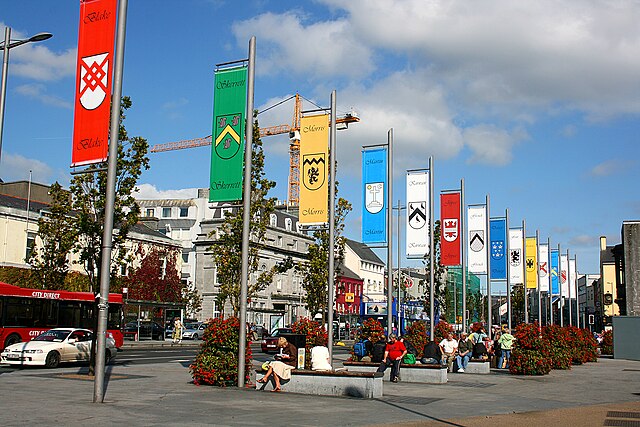Top Qs
Timeline
Chat
Perspective
Eyre Square
Square in Galway, Ireland From Wikipedia, the free encyclopedia
Remove ads
Eyre Square (/ɛər/ AIR; Irish: An Fhaiche Mhór) is a city public park in Galway, Ireland. The park is within the city centre, adjoining the nearby shopping area of William Street and Shop Street. Galway railway station is adjacent to Eyre Square.
The park is rectangular, surrounded on three sides by streets that form the major traffic arteries into Galway city centre; the west side of the square was pedestrianised in 2006. The square is occasionally although rarely sometimes referred to as John F. Kennedy Memorial Park.
Remove ads
History
Summarize
Perspective

The origin of the square comes from medieval open space in front of a town gate, known as the Green. Markets mostly took place in the northern part of the space. The earliest endeavour to formally enclose it was recorded in 1631. Some ash-trees were planted and the park was enclosed by a wooden fence. The plot of land that became Eyre Square was officially presented to the city in 1710 by Mayor Edward Eyre, from whom it took its name.[1] In 1801, General Meyrick erected a stone wall around the square, which was later known as Meyrick Square.[2] In the middle of the 19th century, the whole park underwent a redevelopment in Georgian style. In the 1960s, a full-scale reconstruction started and iron railings were removed and raised around the backyard of St. Nicholas' Collegiate Church.
Bust commemorating Kennedy's time in Galway
In 1965, the square was officially renamed "John F. Kennedy Memorial Park" in honour of U.S. President John F. Kennedy; despite the renaming, the square is still widely known as Eyre Square. Kennedy had visited Galway City and made a speech in the square on 29 June 1963,[1] the first U.S. president to do so during his term of office. A monument dedicated to JFK was erected on the site of his address, and later replaced by a bust in 2005.[3]
A controversial and massively over-budget redevelopment of the square began in 2004.[4] There was considerable unease in the city when it was reported that the original building contractors, Samuel Kingston Construction Ltd, had left the site and were not returning.[5] After many long delays the square finally reopened on 13 April 2006 having astonishingly cost over €20 million to redevelop.[6] Despite an unpopular reception by Galway natives, the finished square received the Irish Landscape Institute Design Award in 2007.[7]

Eyre Square hosted the third-longest Occupy camp in the world, running for 7 months from October 2011 until May 2012.[8] Inspired by Occupy Wall Street, a group of Galwegians established the camp to protest social injustices and the lack of accountability among states and banking institutions, using the public space to hold general assemblies, workshops and debates. The camp, maintained by a mix of volunteers, aimed to highlight the wealth divide between the 1% who profited from the 2009 banking crash and the 99% who bore its consequences.[9] On 16 May 2012 the camp was cleared by 50 members of Garda Siochana, with one person arrested.[10] One year later, participants and supporters returned for one day of public discussion and discourse at Eyre Square.[8]
Remove ads
Statues and attractions
Summarize
Perspective


Before the most recent, controversial re-landscaping, the park used to house two large cast-iron cannons which were presented in recognition of the service of the Connaught Rangers, an Irish Regiment in the British Army, in the Crimean War.[11] A statue of Irish language writer Pádraic Ó Conaire was erected in his memory in 1935.[11] There is a portrait bust of U.S. President John F. Kennedy in the park,[11] and a statue of Liam Mellows (1892–1992), a hero of the War of Independence, in the car park to the east of the Browne doorway.
The Browne doorway is also another attraction in Eyre Square; it was originally the doorway of the Browne family's home on Lower Abbeygate Street, but was moved in 1905 from Abbeygate Street to Eyre Square. Recently it has had to be shored up, buttressed and encased in plexiglass due to neglect. The name of the Browne family is also featured on one of the fourteen flags near the Browne doorway and the Quincentennial Fountain. These flags represent the Tribes of Galway (Treibheanna na Gaillimhe), fourteen merchant families who dominated the political, commercial, and social life of the city of Galway in western Ireland between the mid-13th and late 19th centuries.
Remove ads
References
External links
Wikiwand - on
Seamless Wikipedia browsing. On steroids.
Remove ads




